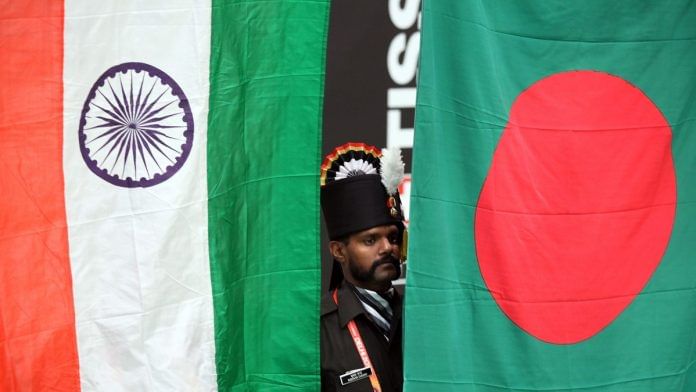India’s Land Port Ban on Bangladeshi Goods: A Message of Reciprocity and Resilience
New Delhi (TheTrendingPeople.): In a major development in regional trade and diplomacy, India has officially restricted imports of Bangladeshi goods through its northeastern land ports, marking a significant shift in its trade posture toward its eastern neighbour. The move, notified in the Gazette of India and implemented on May 17, follows weeks of diplomatic tension and long-standing trade asymmetries between the two nations.
The ban affects Bangladeshi ready-made garments (RMG) and several other categories such as plastics, melamine, processed food, bakery items, and beverages, which will now only be allowed through Kolkata Port in West Bengal or Nhava Sheva Port in Maharashtra — both hundreds of kilometers from the border, substantially raising freight and handling costs for Bangladeshi exporters.
Trigger: Diplomatic Misstep or Strategic Recalibration?
The immediate trigger for India’s restriction appears to be comments made by Bangladesh’s interim Chief Adviser Muhammad Yunus during a visit to China, where he referred to India’s northeastern region as “landlocked with no ocean access.” Indian policymakers saw the remark not just as inaccurate, but as diplomatically insensitive — especially given the region's increasing strategic relevance in connectivity, trade, and national integration.
“This wasn’t just a factual error. It was perceived as a diplomatic slight undermining our Northeastern region's integration and connectivity progress,” a senior Indian government source told TheTrendingPeople.com.
However, the decision appears to go beyond rhetoric, reflecting India’s growing desire to enforce a more balanced and reciprocal trade relationship with Bangladesh.
A Long-Standing Trade Imbalance
While Bangladesh has benefited from unhindered access to Indian markets, especially through the northeastern states, India has faced persistent barriers to its own exports, such as high tariffs on Indian yarn, restrictions on rice, and frequent, arbitrary customs inspections at Bangladeshi ports.
According to sources, 93% of Bangladesh’s exports to India previously entered through northeastern land ports, accounting for USD 770 million in goods annually, including USD 740 million in garments alone. India’s Global Trade Research Initiative (GTRI) notes that 42% of total bilateral imports from Bangladesh are impacted by the new directive.
“India is simply restoring balance. The North East is not a captive market for Bangladesh, especially when it denies India equitable transit and access,” a trade expert at GTRI explained.
Strategic Fallout and Industry Impact
The sudden change will deal a sharp blow to Bangladesh’s RMG sector, which has long used the geographical proximity of India’s northeast to gain a logistical and pricing edge. With rerouting now required through seaports, logistics costs are expected to spike, making Bangladeshi products less competitive.
This opens the door for Indian manufacturers to capture greater market share, particularly in the garment and processed food sectors. Local industries in states like Assam, Tripura, and Meghalaya could benefit from the vacuum left behind by pricier Bangladeshi imports.
The move also sends a strong message to South Asian neighbours: trade asymmetries and one-sided transit arrangements will no longer go unchallenged.
Not a Blanket Ban: Essential Goods Exempt
To avoid humanitarian or essential service disruptions, the notification makes clear that imports of fish, LPG, edible oil, and crushed stones remain unaffected. Moreover, goods transiting from Bangladesh to Nepal and Bhutan via India are also exempted — indicating that India’s objective is trade balance, not blockade.
A Shift in Trade Doctrine: Reciprocity over Generosity
This development marks a clear pivot in India’s trade diplomacy. For years, India provided near-unfettered access to its markets, especially to immediate neighbours under the SAARC and BIMSTEC frameworks. However, recent moves — including restrictions on rice exports, tightening of FDI norms from bordering countries, and now this land port import restriction — suggest a shift toward a policy of “strategic reciprocity.”
“India will not tolerate cherry-picking of trade benefits while bearing all the costs of goodwill,” said a senior trade official involved in drafting the directive.
Diplomatic Calculus and Next Moves
While no official diplomatic protest has been lodged by Bangladesh so far, analysts expect tensions to rise in bilateral talks, particularly around transit agreements and connectivity corridors like the BBIN (Bangladesh, Bhutan, India, Nepal) initiative and South Asia Subregional Economic Cooperation (SASEC).
However, New Delhi’s message is clear: mutual respect, balanced market access, and policy parity are no longer optional in South Asia’s evolving trade landscape.
Cautionary Tale and an Opportunity
India’s decision to restrict land port access to Bangladeshi goods is not just a tit-for-tat diplomatic measure, but a larger assertion of strategic autonomy and regional trade balance. While Bangladesh may temporarily struggle with the rerouting of its exports, the situation also offers a wake-up call to reboot trade ties on equitable and forward-looking terms.
For Indian industry, it’s an opening to step up production, fill supply gaps, and strengthen the manufacturing ecosystem in the Northeast — all while signalling that India’s generosity should not be mistaken for weakness.
Image source: The Print with inputs fromthe agency

